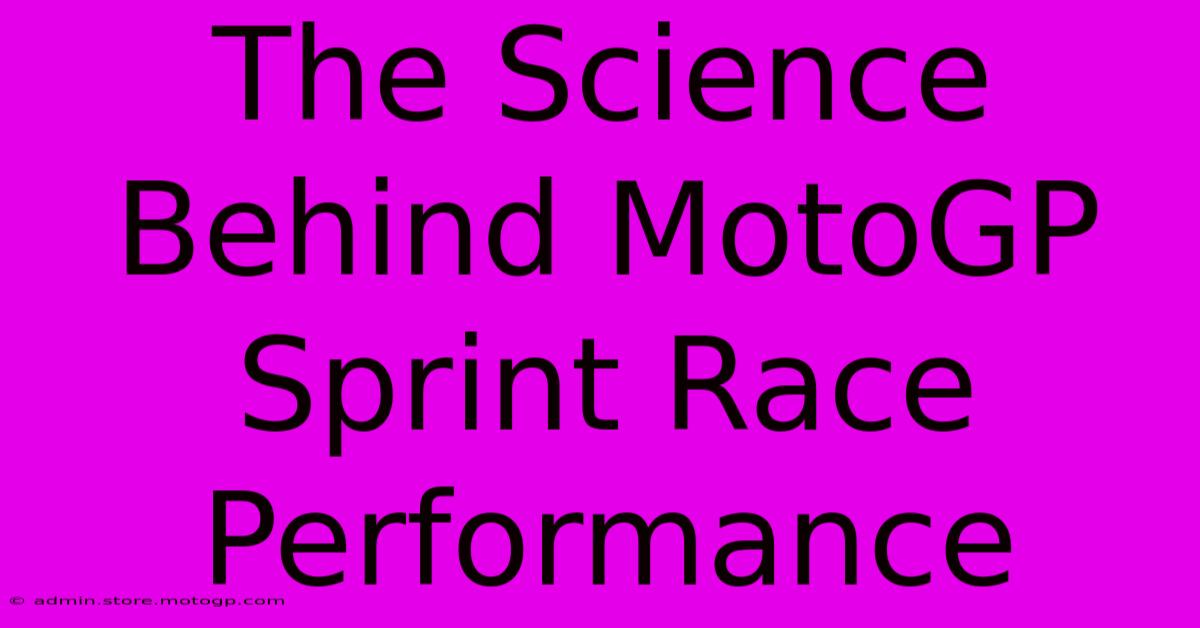The Science Behind MotoGP Sprint Race Performance

Table of Contents
The Science Behind MotoGP Sprint Race Performance
MotoGP's introduction of the sprint race has added a thrilling new dimension to Grand Prix weekends. But beyond the spectacle, there's a fascinating interplay of science and strategy that dictates success in these shorter, intense bursts of speed. This article delves into the scientific principles influencing performance in MotoGP sprint races, exploring the crucial factors contributing to a rider's ability to clinch victory.
The Physics of Short, Sharp Races
Sprint races demand a different approach compared to the traditional longer races. The shorter distance means less time for tire management, fuel conservation, and strategic pit stops. Instead, peak performance becomes paramount.
1. Tire Degradation and Grip: A Critical Factor
In a sprint race, tire degradation is accelerated. The intense acceleration, braking, and cornering put immense stress on the tires, leading to faster wear and reduced grip. Choosing the right tire compound, understanding its performance characteristics under various conditions (temperature, track surface), and managing tire temperature become crucial for maintaining optimal grip throughout the race. Tire pressure monitoring and adjustment also play a significant role in achieving consistent performance.
2. Engine Performance and Power Delivery: Maximizing Output
The sprint's short duration necessitates a different engine mapping strategy compared to feature races. Riders and engineers prioritize maximum power output and responsiveness. This translates to maximizing engine torque at critical points, such as corner exits, where rapid acceleration is paramount. Engine efficiency, while important, takes a backseat to achieving peak power in this intense context. Engine mapping adjustments are finely tuned for optimal performance during the short race distance.
3. Aerodynamics: The Science of Speed and Stability
Aerodynamics play a significant role in high-speed stability and cornering performance, especially crucial for maintaining speed through the race's shorter time frame. Minimizing drag and maximizing downforce are essential for achieving high cornering speeds and stability on the straights. Even minor adjustments to aerodynamic settings, like winglet angles, can impact lap times significantly.
The Human Element: Rider Fitness and Mental Fortitude
Beyond the mechanics, the sprint race format demands exceptional physical and mental capabilities from the riders.
1. Physical Fitness and Stamina: Peak Conditioning is Key
While the race is shorter, it's intensely demanding. Riders need exceptional physical fitness to withstand the continuous high-g forces and maintain peak concentration throughout. Strength, endurance, and reaction time are critical factors influencing performance, requiring rigorous training programs focused on these aspects.
2. Mental Focus and Decision-Making Under Pressure: The Winning Edge
Sprint races are high-pressure environments. Riders must make quick, decisive decisions, maintain focus throughout intense battles, and manage risk effectively to avoid mistakes. Mental preparation and training are as critical as physical conditioning, improving a rider's ability to handle the stress and pressure.
3. Race Strategy: Aggression versus Conservation?
While fuel and tire conservation are less critical, strategy still plays a crucial role. The sprint race format often encourages a more aggressive riding style, as overtaking opportunities are maximized in the shorter distance. However, striking a balance between aggressive overtaking and minimizing risk of accidents is essential to a successful outcome.
Conclusion: A Complex Interplay of Science and Skill
The success in a MotoGP sprint race isn't solely about raw power and speed. It's a sophisticated blend of scientific principles—tire management, engine performance, and aerodynamics—combined with the rider's physical and mental prowess. The shorter format intensifies these factors, making the sprint race a captivating display of both technological advancement and human skill. The constant optimization and adaptation by riders and teams showcase the ever-evolving science of MotoGP. This intricate interplay continues to push the boundaries of motorsport performance.

Thank you for visiting our website wich cover about The Science Behind MotoGP Sprint Race Performance. We hope the information provided has been useful to you. Feel free to contact us if you have any questions or need further assistance. See you next time and dont miss to bookmark.
Featured Posts
-
Moto Gp Sprint Race The Heart Of Moto Gp
Feb 19, 2025
-
Cota Your Transportation Checklist
Feb 19, 2025
-
Moto Gp Engineering At Its Finest Bike For Sale
Feb 19, 2025
-
Tnt Sports Your Ultimate Moto Gp Companion
Feb 19, 2025
-
Cota Grounds Pass More Than Just A Race
Feb 19, 2025
